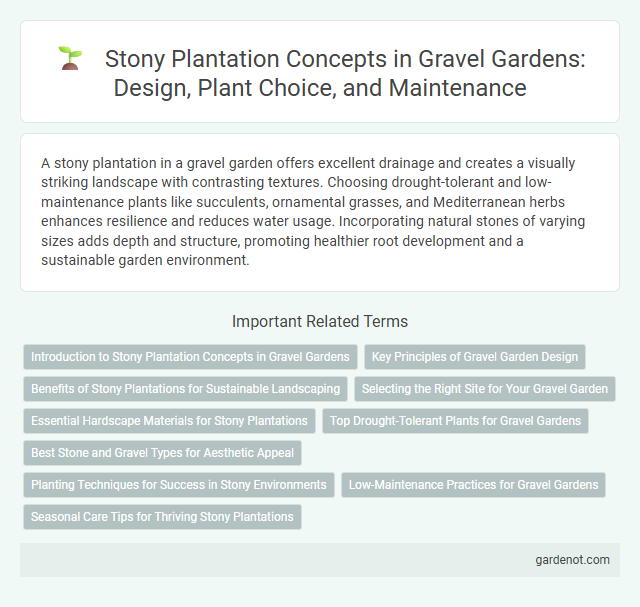A stony plantation in a gravel garden offers excellent drainage and creates a visually striking landscape with contrasting textures. Choosing drought-tolerant and low-maintenance plants like succulents, ornamental grasses, and Mediterranean herbs enhances resilience and reduces water usage. Incorporating natural stones of varying sizes adds depth and structure, promoting healthier root development and a sustainable garden environment.
Introduction to Stony Plantation Concepts in Gravel Gardens
Stony plantation in gravel gardens integrates drought-tolerant plants with rocky substrates to create sustainable, low-maintenance landscapes. Utilizing native succulents, ornamental grasses, and hardy perennials enhances water conservation and soil stability. This method supports biodiversity while complementing the aesthetic appeal of gravel textures and natural stone elements.
Key Principles of Gravel Garden Design
Stony plantations in gravel gardens maximize drainage and minimize soil compaction, creating ideal conditions for drought-tolerant plants such as sedums, lavenders, and ornamental grasses. Key principles include selecting stones that complement plant textures and colors, ensuring proper spacing to prevent overcrowding, and layering gravel with different sizes for natural water retention and root protection. Integrating native drought-resistant species with well-graded gravel enhances biodiversity and reduces maintenance while maintaining aesthetic harmony.
Benefits of Stony Plantations for Sustainable Landscaping
Stony plantations enhance sustainable landscaping by improving soil drainage, reducing erosion, and conserving water through natural rock barriers. These plantations create microhabitats that promote biodiversity, supporting beneficial insects and drought-resistant plants. Incorporating stones reduces the need for chemical fertilizers and irrigation, fostering an eco-friendly and low-maintenance garden environment.
Selecting the Right Site for Your Gravel Garden
Choosing the ideal site for a gravel garden involves assessing soil drainage and sunlight exposure to ensure plant health and aesthetic appeal. Opt for locations with well-draining soil to prevent waterlogging and select a spot that receives at least six hours of direct sunlight daily to support drought-tolerant species commonly used in stony plantations. Proper site selection enhances the longevity and low-maintenance nature of your gravel garden, promoting vibrant plant growth and reducing the need for frequent irrigation.
Essential Hardscape Materials for Stony Plantations
Essential hardscape materials for stony plantations in gravel gardens include crushed stone, flagstones, and gravel, which provide both structural integrity and aesthetic appeal. Durable edging materials such as metal or stone retainers are crucial for maintaining clean boundaries and preventing soil erosion. Permeable pavers enhance drainage while supporting plant growth, ensuring a balanced and sustainable hardscape environment.
Top Drought-Tolerant Plants for Gravel Gardens
Stony plantations in gravel gardens thrive with top drought-tolerant plants such as Sedum, Sempervivum, and Lavandula, which require minimal water and flourish in well-drained soils. These resilient succulents and Mediterranean herbs reduce maintenance while enhancing texture and color contrast against gravel beds. Incorporating drought-resistant grasses like Festuca and ornamental stonecrop species further improves garden sustainability and visual appeal.
Best Stone and Gravel Types for Aesthetic Appeal
Choosing the best stone and gravel types for a stony plantation enhances its visual appeal and complements surrounding plants. Popular options include pea gravel for smooth texture, crushed granite for durability and vibrant color, and limestone for a classic, neutral appearance. Selecting stones based on size, color, and texture creates a cohesive, attractive gravel garden that supports drainage and weed control.
Planting Techniques for Success in Stony Environments
Planting techniques for success in stony environments involve selecting drought-tolerant, deep-rooted species that can anchor securely within rocky substrates. Utilizing gravel mulch aids moisture retention while preventing weed growth, optimizing soil aeration and drainage crucial for root health. Strategic spacing ensures adequate airflow and reduces competition, promoting robust plant development in gravel garden settings.
Low-Maintenance Practices for Gravel Gardens
Stony plantations in gravel gardens thrive with minimal care by selecting drought-tolerant, native plants such as sedums, lavenders, and ornamental grasses that require limited watering and pruning. Incorporating permeable gravel mulch enhances soil drainage while suppressing weeds, reducing the need for chemical interventions. Implementing drip irrigation systems optimizes water use efficiency, ensuring sustainable maintenance for stony gravel garden landscapes.
Seasonal Care Tips for Thriving Stony Plantations
Stony plantations in gravel gardens require well-drained soil and regular monitoring to prevent waterlogging during rainy seasons. Pruning dead or diseased branches in early spring promotes healthy growth, while mulching reduces weed competition and retains soil moisture throughout the year. Applying slow-release fertilizers in late winter supports nutrient uptake, ensuring vibrant and resilient plants across all seasons.
Stony plantation Infographic

 gardenot.com
gardenot.com